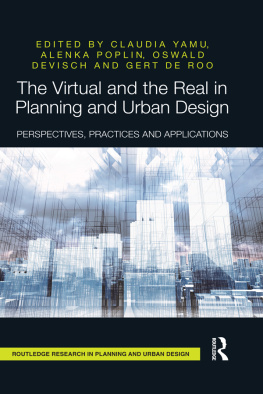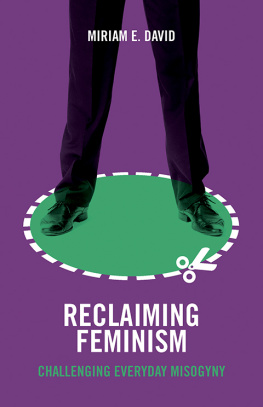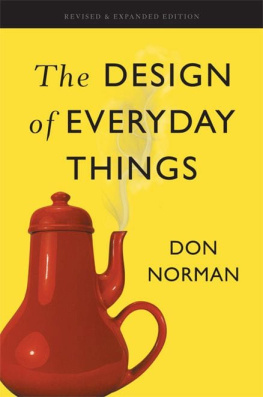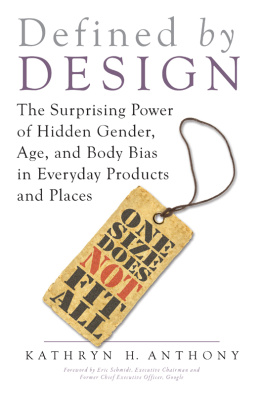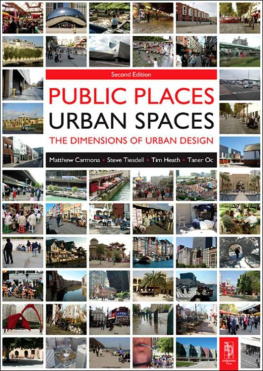Joan Rothschild (editor) - Design and Feminism: Re-Visioning Spaces, Places, and Everyday Things
Here you can read online Joan Rothschild (editor) - Design and Feminism: Re-Visioning Spaces, Places, and Everyday Things full text of the book (entire story) in english for free. Download pdf and epub, get meaning, cover and reviews about this ebook. year: 1999, publisher: Rutgers University Press, genre: Home and family. Description of the work, (preface) as well as reviews are available. Best literature library LitArk.com created for fans of good reading and offers a wide selection of genres:
Romance novel
Science fiction
Adventure
Detective
Science
History
Home and family
Prose
Art
Politics
Computer
Non-fiction
Religion
Business
Children
Humor
Choose a favorite category and find really read worthwhile books. Enjoy immersion in the world of imagination, feel the emotions of the characters or learn something new for yourself, make an fascinating discovery.
- Book:Design and Feminism: Re-Visioning Spaces, Places, and Everyday Things
- Author:
- Publisher:Rutgers University Press
- Genre:
- Year:1999
- Rating:5 / 5
- Favourites:Add to favourites
- Your mark:
- 100
- 1
- 2
- 3
- 4
- 5
Design and Feminism: Re-Visioning Spaces, Places, and Everyday Things: summary, description and annotation
We offer to read an annotation, description, summary or preface (depends on what the author of the book "Design and Feminism: Re-Visioning Spaces, Places, and Everyday Things" wrote himself). If you haven't found the necessary information about the book — write in the comments, we will try to find it.
Design and Feminism: Re-Visioning Spaces, Places, and Everyday Things — read online for free the complete book (whole text) full work
Below is the text of the book, divided by pages. System saving the place of the last page read, allows you to conveniently read the book "Design and Feminism: Re-Visioning Spaces, Places, and Everyday Things" online for free, without having to search again every time where you left off. Put a bookmark, and you can go to the page where you finished reading at any time.
Font size:
Interval:
Bookmark:

and Everyday Things
Edited by
Joan Rothschild
With the assistance of Alethea Cheng Etain Fitzpatrick Maggie Mahboubian Francine Monaco Victoria Rosner
Both popular culture and the academic aristocracy have in past decades forced us to realize that the world is made of the combination and interaction of many subgroups and their own subtexts and that there is no validity in using absolute viewpoints or in referring to a mainstream. As a matter of fact, those lingering absolutes are often considered signs of fanaticism. Presidents of countries and multinational companies are retroactively acknowledging the sins that have been committed in the name of their own absolute viewpoints, and are apologizing to the communities they have offended and damaged in the past. At this point in the evolution of human thought, feminist critique has lost its initial role of outsider opposition and has at last affirmed itself as a necessary complement to all social studies.
The dismantling of the absolute began in science a long time ago, but only recently has it percolated down to the study of human actions and interactions. Geometry, one of the disciplines that has claimed to describe physical reality, has been among the first to take steps in this direction. The Euclidean models that were in ancient times sufficient to describe the world, even though they were only crudely approximate in their amputation of many of the details that make nature a work of genius, have been challenged throughout the centuries. However, in the 1950s the most recent geometries, such as the one based on Benoit Mandelbrot's fractals, have focused on finding recurrence in what seem complex exceptions, like snowflakes and coastal lines. Physics had already by the 1950s claimed its primary place with Einstein's construct and the quantum theory, while at the same time economics scholars introduced the word "deviance" to describe all the exceptions that influence and mutate the so-called norm. Since then, all disciplines, from philosophy to design, have made attempts to introduce into or impose on their basic dogmas diversification and instant change of perspective.
The 1950s was also a time when the first unconscious feminist overhaul from within the system occurred; the phenomenon was described by producer Jacqueline Donnet in her groundbreaking documentary Paving the Way, which aired on PBS in 1996. In the documentary, Donnet explains the pioneering lives of four women of the 1950s: Ruth Bader Ginsburg, Supreme Court justice; Jeanne Holm, a major general in the U.S. Air Force; Rev. Addie Wyatt, the first African American female labor organizer for the meatpacking union in Chicago; and Patsy Mink, congresswoman from Hawaii. These women were able to organize their lives, which also included families, in such a way as to intrude their unique "marginal" viewpoint into some of the fortresses of mainstream male power and make quantum changes.
Their systemic revolution had characteristics in common with today's feminist activism and attitudes. Today, when the word "mainstream" has become blurred and ambiguous and what was once considered fringe has become the core of reality, feminist criticism is operating from within the system. It has the same necessary function as fractal geometry: that of describing reality in closer, truer, and more revealing detail. Women and other groups-ethnic, economic, religious-have at last acquired cultural power in part because of their having been marginalized in the past. Therefore, it is almost axiomatic that feminist critics do not wish to impose any absolute viewpoint and call instead for all other relative critiques to complete and enrich the picture.
Feminist critics are thus not concerned with reclaiming the whole world and declaring whose time it is but rather are taking the necessary steps to complete and revise history, while helping to focus attention on what used to be considered subtext. In the realm of architecture and design, feminist criticism no longer seeks merely to reevaluate important background women like Charlotte Perriand, Ray Eames, or Lilly Reich. The authors represented in this book, many of them pioneers in their own discrete fields, rather attempt to provide with their passionate and lucid accounts an insight into the real built world of the past and present. They focus on real design and architecture, which are made not only of symbolic monuments and peaks but also of the cities, objects, and buildings that have made everybody's real experience and given form to everybody's material culture.
When a project is the result of the support and the collective efforts of so many persons and institutions-many of whom were also involved in the conference that gave rise to the book-it is perhaps not possible to acknowledge the myriad ways each contributed. I can only try.
My first debt is to the Graham Foundation for Advanced Study in the Fine Arts for support to the editor to prepare the book, generously following up its role as major funder of the CUNY "ReVisioning Design and Technology" conference in 1995. My warm thanks to Emma Espino Macari, vice chancellor for facilities at the City University of New York, who arranged for CUNY's contributions to the conference and has helped to underwrite preparation of the book. The institutional support of the Center for Human Environments (CHE) at the Graduate School and University Center at CUNY has been invaluable. It would not have been possible to produce this book without computer, phone, mailing, fax, photocopying, and countless other office facilities or the innumerable ways the people and atmosphere of the Housing Environment Research Group [HERG] at CHE helped. (What would I have done without Karen Peffley and Helene Clark to convert those Mac disks to DOS?) My special debt of thanks to Susan Saegert, current director of CHE, who believed in me from the beginning when I brought the conference idea to her. Her continuing encouragement, counsel, and friendship are irreplaceable.
Obviously, there would have been no book without the contributors and their original conference presentations, or their reworking-sometimes completely rewriting-them, sometimes many times over. The quality of your finished work testifies to your efforts. I thank each of you for your patience over what became a very long process and your support of me throughout. To my coauthor of the review essay, it was a pleasure working with you, Victoria, even as we disagreed, and agreed, and learned much from each other in the process.
"With the assistance of" preceding the names listed on the title page does not do justice to the extraordinary role these women played in producing this book. Alethea Cheng, Etain Fitzpatrick, Maggie Mahboubian, and Francine Monaco each participated in the conference; Francine also served on the planning committee and moderated one of the conference workshops. Forming a publications committee, the four joined with me to produce a book that would reflect the spirit of the conference and carry the work beyond it. These young architects-all working full-time in a profession that does not know the meaning of "nine-to-five"-devoted their "spare time," their evenings and weekends, over an almost two-year period to the project. Selecting and organizing and reselecting and reorganizing, contacting authors and reworking the manuscripts, engaging in endless discussions about "feminism[s]" and about our concepts of the hook, they devoted their energies, enthusiasms, and talents to our project. Their visual orientation was especially valuable, as were their perspectives as part of a new generation entering the design fields. Victoria Rosner joined us a little more than a year into the project. She contributed her considerable editorial skills (as a graduate student in literature) to a number of the essays as well as bringing a fresh eye to what we had accomplished before her arrival. My heartfelt thanks to all of you.
Font size:
Interval:
Bookmark:
Similar books «Design and Feminism: Re-Visioning Spaces, Places, and Everyday Things»
Look at similar books to Design and Feminism: Re-Visioning Spaces, Places, and Everyday Things. We have selected literature similar in name and meaning in the hope of providing readers with more options to find new, interesting, not yet read works.
Discussion, reviews of the book Design and Feminism: Re-Visioning Spaces, Places, and Everyday Things and just readers' own opinions. Leave your comments, write what you think about the work, its meaning or the main characters. Specify what exactly you liked and what you didn't like, and why you think so.



